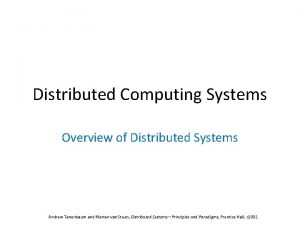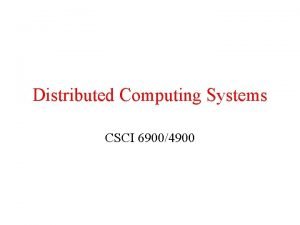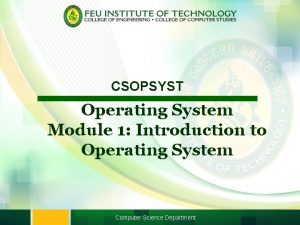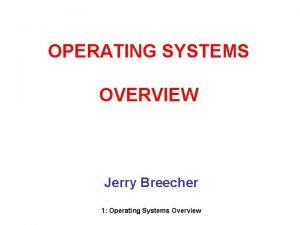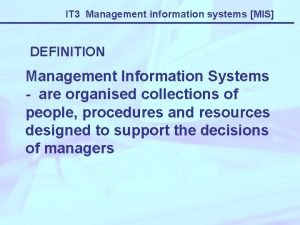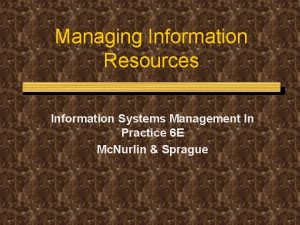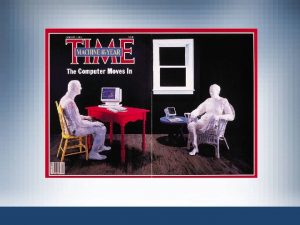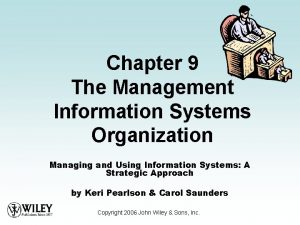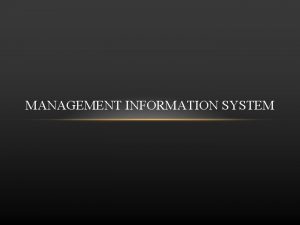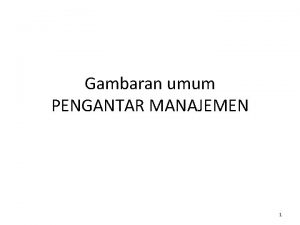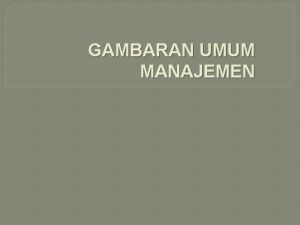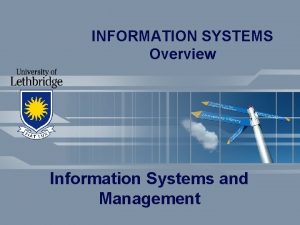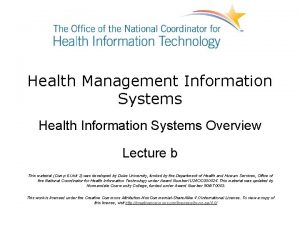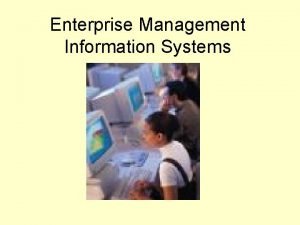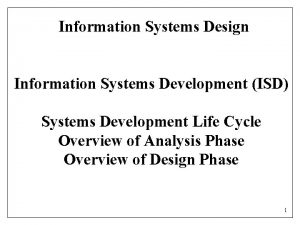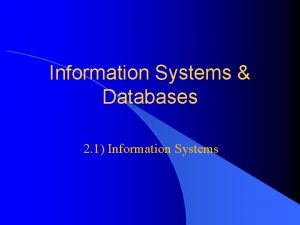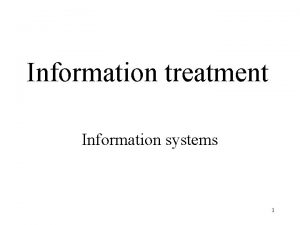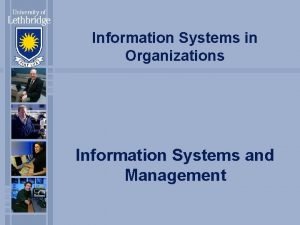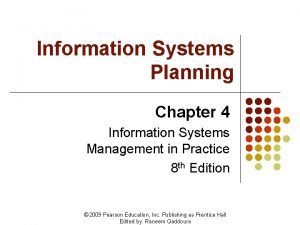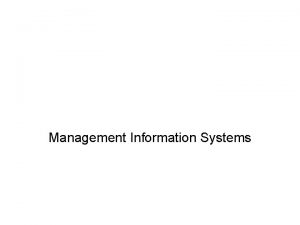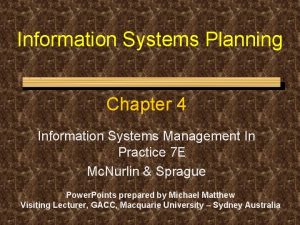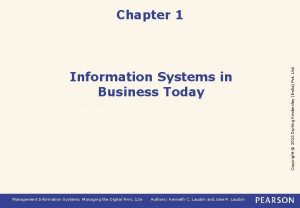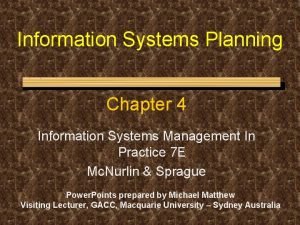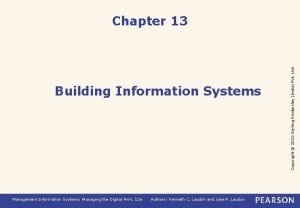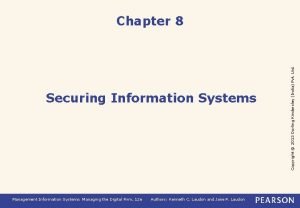An Overview of Management Information Systems Management information





























- Slides: 29

An Overview of Management Information Systems ØManagement information system (MIS) ØIntegrated collection of people, procedures, databases, and devices ØProvides managers and decision makers with information to help achieve organizational goals ØCan give the organization a competitive advantage 1

MIS ØProviding the right information to the right people in the right format and at the right time ØProvides managers with information that supports effective decision making and provides feedback on daily operations 2

Inputs to MIS ØInternal data sources ØExternal data sources ØTPSs and ERP systems and related databases ØData warehouses and data marts ØSpecific functional areas throughout the firm ØCustomers, suppliers, competitors, and stakeholders whose data is not already captured by the TPS ØInternet ØExtranets 3

Outputs of MIS ØScheduled report ØProduced periodically: daily, weekly, or monthly ØKey-indicator report ØAt beginning of workday, for quick, corrective action ØSummary of previous day’s critical activities: sales, inventory. . . 4

ØDemand report ØDeveloped to give certain info at someone’s request Øe. g. Fed. Ex’ site allows customers to track packages ØException report ØAutomatically produced when a situation is unusual or requires management action ØDrill-down salesrep) reports (e. g. company to dept to ØProvide increasingly detailed data about a situation 5

System Applications in the Organization Because there are different interests, specialties, and levels in an organization, there are different kinds of systems. No single system can provide all of the information an organization needs. Systems are built to serve these different organizational interests.

Different Kinds of Systems Four main types of information system serve different organizational levels: 1. Operational-level systems ◦ support operational managers by keeping track of the elementary activities and transactions of the organization, such as sales, receipts, cash deposits, payroll, credit decisions, and the flow of materials in a factory.

Different Kinds of Systems 2. knowledge-level systems ◦ support the organization’s knowledge and data workers. ◦ The purpose of knowledge-level systems is to help the business firm integrate new knowledge into the business and to help the organization control the flow of paperwork.

Different Kinds of Systems 3. Management-level systems ◦ serve the information systems that support the monitoring, controlling, decision-making, and administrative activities of middle managers.

Different Kinds of Systems 4. Strategic-level systems ◦ help senior management tackle and address strategic issues and long-term trend, ◦ both in the firm and in the external environment. ◦ Information systems also serve the major business functions, such as sales and marketing, manufacturing, finance, accounting, and human resources.


Systems From a Functional Perspective Information systems can be classified by the specific organizational function they serve as well as by organizational level.

Major Types of Systems 1. Transaction Processing Systems (TPS) are the basic business systems that serve the operational level of the organization. A transaction processing system is a computerized system that performs and records the daily routine transactions necessary to conduct the business.

Major Types of Systems 2. Knowledge Work and Office Systems ◦ Knowledge Work System (KWS) and office systems serve the information needs at the knowledge level of the organization. ◦ Knowledge workers are people who hold formal university degree and who are often members of a recognized profession, such as engineers, doctors, lawyers, and scientists. ◦ Data workers typically have less formal, advanced educational degrees and tend to process rather than create information.

Major Types of Systems 3. Management Information Systems ◦ The term management information systems (MIS) also designates a specific category of information systems serving management-level functions. ◦ Management Information Systems (MIS) refer information systems at the management level of an organization that serve the functions of planning, controlling, and decision making by providing routine summary and exception reports.

Major Types of Systems 4. Decision-Support Systems ◦ Decision-Support Systems (DSS) also serve the management level of the organization. ◦ DSS help managers make decisions that are unique, rapidly changing, not easily specified in advance. ◦ They address problems where the procedure for arriving at a solution may not be fully predefined in advance.

DSS Decision support system (DSS) ◦ Organized collection of people, procedures, software, databases, and devices used to help make decisions that solve problems Focus of a DSS is on decision-making effectiveness regarding unstructured or semistructured business problems Used by managers at all levels 17

Problems Structured Semistructured Unstructured Structured ◦ Routine problems with known solution and info e. g. Which customers did not pay? ◦ Management level involved _________ Semistructured ◦ Less routine problems ◦ Involves subjective judgment; info may not be available e. g. Which products should we sell? ◦ Management level involved _________ Unstructured ◦ Requires human intuition for decisions; info is missing Decrease cold weather inventories due to global warming? ◦ Management level involved _________

Examples of Characteristics of a DSS What-if analysis ◦ Manipulate input for desired output ◦ Making hypothetical changes to problem data and observing impact on results Goal-seeking analysis ◦ Manipulate output for desired input ◦ Determining problem data required for a given result Simulation ◦ Ability to duplicate features of a real system ◦ War games; different marketing decisions under various market conditions; drug testing in simulated trials Spreadsheets (e. g. Excel: Data ribbon) 19

Capabilities of a DSS span all levels of management Figure 10. 14: Decision-Making Level 20

5. Group Support Systems Group support system (GSS) ◦ Consists of most elements in a DSS, plus software to provide effective support in group decision making ◦ Also called group decision support system (GDSS) or computerized collaborative work system 21

GSS Software Often called groupware or workgroup software Helps with joint work group scheduling, communication, and management Examples ◦ Windows Meeting Space (in Vista) A built-in social collaboration technology for small groups Replaced Net. Meeting in Windows XP Not in Windows 7 ◦ MS Share. Point Workspace 2010 An ecollaboration/virtual teams software program ◦ MS Office Live Meeting (with panoramic Round. Table) ◦ Lotus Domino (previously Notes) from IBM 22

GSS Software (continued) More GSS software examples ◦ Lotus Domino (previously Notes) from IBM ◦ Virtual Office from Groove Networks ◦ Lync (Microsoft) Examples of groupware products available on the web ◦ Cisco Web. Ex ◦ Genesys Meeting Center ◦ Go. To. Meeting Corporate 23

Major Types of Systems 6. Executive Support Systems ◦ Senior managers use executive support systems (ESS) to make decisions. ◦ ESS serves the strategic level of the organization. ◦ ESS are design to incorporate data about external events such as new tax laws or competitors, but they also draw summarized information from internal MIS and DSS.

Examples of specific systems Sales and Marketing Systems ◦ The sale and marketing function is responsible for selling the organization’s products or services. ◦ Marketing is concerned with identifying the customers for the firm’s products or services, determine what they need or want, planning and developing products and services to meet their needs, and advertising and promoting these products and services.

Examples of systems Manufacturing and Production Systems ◦ The manufacturing and production function is responsible for actually producing the firm’s goods and services. ◦ Manufacturing and production activities deal with the planning, development, and maintenance of production facilities; the establishment of production goals; ◦ the acquisition, storage, and availability of production materials; and the scheduling of equipment, facilities, materials, and labour required to fashion finished products.

Examples of systems Finance and Accounting Systems ◦ The finance function is responsible for managing the firm’s financial assets, such as cash, stocks, bonds, and other investments, ◦ in order to maximize the return on these financial assets. ◦ The finance function is also in charge of managing the capitalization of the firm. ◦ In order to determine whether the firm is getting the best return on its investments, the finance function must obtain a considerable amount of information from sources external to the firm.

Examples of systems Human Resources Systems ◦ The human resource function is responsible for attracting, developing, and maintaining the firm’s workforce. ◦ Human resources information systems support activities such as identifying potential employees, maintaining complete records on existing employees, and creating programs to develop employees’ talents and skills.

Examples of systems ◦ Strategic-level human resources system identify the employee requirements (skills, educational level, types of positions, number of positions, and cost) for meeting the firm’s long term business plans.
 Distributed systems overview
Distributed systems overview Sap ps
Sap ps Introduction to distributed computing
Introduction to distributed computing Overview of operating systems
Overview of operating systems Operating systems overview
Operating systems overview Management information systems chapter 1
Management information systems chapter 1 Tps example
Tps example Definition of information system
Definition of information system Information systems management in practice
Information systems management in practice Vertical
Vertical Information
Information Mis chapter 9
Mis chapter 9 Management information systems 13th edition
Management information systems 13th edition Management information systems effy oz
Management information systems effy oz Introduction to management information systems 5th edition
Introduction to management information systems 5th edition Management information systems managing the digital firm
Management information systems managing the digital firm Introduction of management information system
Introduction of management information system Management information system chapter 1
Management information system chapter 1 Database content management system
Database content management system Intro to human resource management
Intro to human resource management Management topics for project
Management topics for project Sequence diagram for gym management system
Sequence diagram for gym management system Real time interaction management
Real time interaction management Management overview
Management overview Management overview
Management overview Overview of financial management
Overview of financial management The commonly accepted goal of the mnc is to:
The commonly accepted goal of the mnc is to: Chapter 1 an overview of financial management
Chapter 1 an overview of financial management An overview of financial management
An overview of financial management Decision support systems and intelligent systems
Decision support systems and intelligent systems
